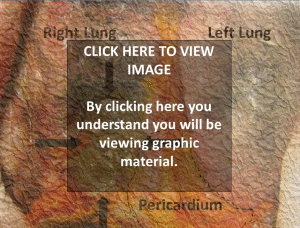What is shown? The photograph shows the right and left lungs and the unopened sac around the heart (pericardium, dashed line) still inside the chest. The arrows point to a region of pus in the right lung. It’s a bit smaller than the size of a playing card and not quite half an inch deep. This is an abscess. The white flecks are fungus (mold). This is a fungal abscess.
What is the clinical history here? This case is of an elderly man with numerous bouts of “pneumonia” and unexplained fevers over several months. Each time, the patient was treated with antibiotics and improved, but the “pneumonia” always came back. The “pneumonia” was first diagnosed by CT scan.
How did the autopsy help the family? The autopsy provided an explanation for a situation that had been a mystery. The family was distressed and confused as to why treatment did not work. The autopsy provided the “big picture” here – that, underneath it all, was an abscess, not a pneumonia. This provided relief to the family, and a sense of peace on one level. Now they knew why their loved one never got better.
Why didn’t the abscess heal with antibiotics? Antibiotics reach areas of infection by travelling through the blood stream. An abscess is a pocket of pus with no blood flow inside it – antibiotics can’t easily get inside. The treatment of an abscess is to drain it surgically. A lung abscess that does not get drained will sit in the body and continue to cause symptoms (fever, breathing problems, general weakness, etc.) or, as in this case, death. In addition, the patient received antibiotics (which treat bacterial infections). The patient needed antifungals because this was a fungal infection.
How did the family manage with this new information? While the family was surprised and relieved, they were angry that the abscess had not been detected prior to the patient’s death. Specifically, they wondered why it was not detected on the initial CT scan. Also, they were angry because they had asserted themselves with providers, questioning the diagnosis and care, but were dismissed.
How did the family discussion proceed from this point? In this case, it was very important to make sure that feelings of guilt were not added to the family’s anger; and to help them manage their anger by providing information and perspective. Specifically, it was not the family’s fault the diagnosis was not made. It was important to value the family’s efforts during the time they cared for their loved one, validate their commitment to their loved one, and emphasize the complexity of the health care system. Also, it was important to give the family as many tools as possible to interpret the situation. For example, regarding their concerns about the first CT scan, the possibilities were that:
-the abscess was not there at that point (e.g., that it developed later)
-the abscess was there but difficult to see for some reason related to its appearance on the CT (e.g., perhaps related to the abscess being relatively flat)
-that the abscess was there but was was missed by the radiologist
While the last possibility was the family’s concern, a discussion of the biology of abscesses and the limitations of radiology studies helped sort through the issues. The discussion provided tools to the family in thinking about the experience, and helped them formulate questions when seeking information from the providers. Fungal abscesses are notoriously difficult to diagnose and often missed.
Summary. By providing concrete information from the autopsy examination and by engaging the family on an educational level, this allowed the family to feel a bit less helpless and a bit more empowered moving forward during their vulnerable and difficult time.


1,988 thoughts on “Monthly case: Fungal abscess”